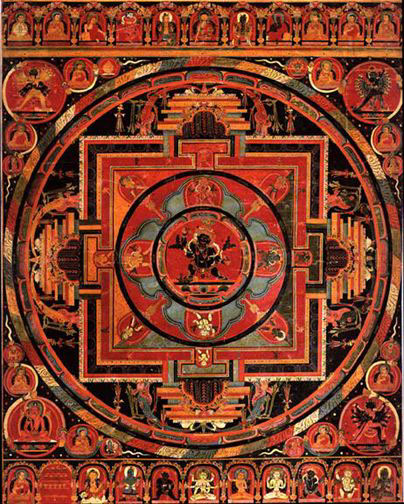
Mandala of an Esoteric Form of Vajrapani
Vajrapani, "he who holds the thunderbolt sceptre," appears at the center
of this mandala in one of his many esoteric forms.1 The three-faced,
four-armed god holds his characteristic thunderbolt sceptre and the
bell, while his other hands grasp the body o
f a serpent, held firm between his teeth and trampled beneath his feet.
His red hair is gathered like a helmet of molded flames, further
adorned with a serpent. A delicate serpent winds about his neck.
The mandala includes in its first circle gods who resemble the central
figure, although they differ in color: white (E), yellow (S), red (W)
and green (N). In the next circle, at the intermediate points of the
compass, are offering goddesses, perhaps the
standard four: Puspa (flowers; NE), Dhupa (incense; SE), Dipa (light,
SW), and Gandha (perfume, NW). There are four guardians of the temple
gates.Outside the mandala proper are esoteric deities in yab-yum ("father-mother"), the posture of sexual embrace; Tibetan teachers (once identified by inscription, now abraded); and the seven jewels of the cakravartin ("universal monarch"): horse, wish-fulfill ing gem (here, probably the triratna or "three jewels of Buddhism" representing the Buddha, the Buddhist doctrine and the monastic community), the elephant, the wheel of the Buddhist law, a general (figure with shield), queen, and a minister who holds tre asure in his hands (here, the god of wealth, Jambhala).2 In the top register is a lineage of mortal and celestial teachers associated with Vajrapani's teachings. The bottom register includes a monk seated before offerings, deities, and protectors of the faith.
No comments:
Post a Comment
Note: Only a member of this blog may post a comment.